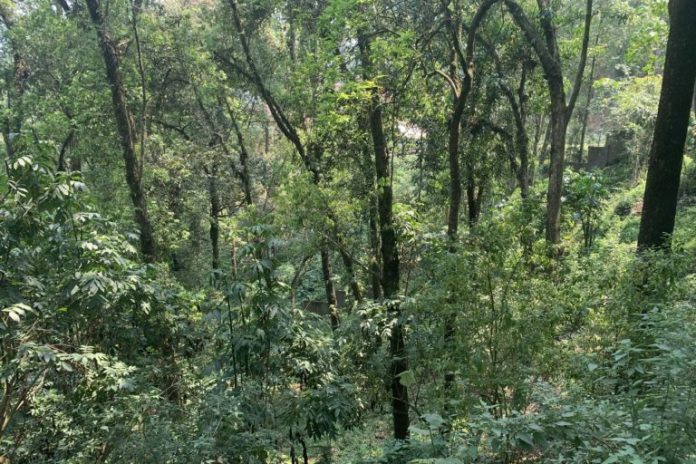
In Sikkim in the eastern Himalayas, religious and cultural ties have helped preserve patches of forests attached to monasteries for centuries. These sacred groves are also crucial to the fight against climate change. A new study finds that carbon mitigated by two undisturbed urban sacred forests in Sikkim is almost double the amount of carbon absorbed and stored by a natural rural forest.
Younger, natural forest had higher carbon sequestration potential than sacred groves
Bijayalaxmi Devi and co-authors reported that the carbon mitigated by the sacred forests was 569.42 Megagram carbon dioxide per hectare in Deorali and 583.34 Mg CO2 per hectare in Enchey, which is almost double when compared to the 280.76 Mg CO2 per hectare in the younger natural rural forest. “However, the younger natural forest had a higher carbon sequestration potential compared to the older counterparts in the sacred sites,” said Bijayalaxmi Devi of the department of botany’s Ecology Laboratory at Sikkim University, Gangtok.

“This is because the rate of carbon sequestration is more influenced by the age of the forest. Young forests sequester more carbon than old forests. As the age of tree increases the carbon sequestration rate decreases,” Bijayalaxmi added. Findings in Sikkim agree with other earlier studies that concluded that young forests function as a better carbon sink, and carbon capture capacity declines after 50 years of stand age. In China, researchers have reported the reduction in carbon sequestration capacity with age in different urban and natural forests.
Bijayalaxmi and co-authors recommend that urban forests including the sacred groves should be properly managed by replacing very old trees with new trees to mitigate the warming of cities. While carrying out interventions in the sacred groves could be sensitive as they are linked to religious beliefs but, researchers pointed out that at Enchey, old trees are harvested for performing religious rites and the same species are replanted.
“Replacing here doesn’t mean total felling of all trees; rather it is the selective harvesting of old trees that have a reduced sequestration capacity. The mechanism depends on the site as sacred sites will have a different replacement strategy, while replacement in other urban forest is not a major issue and can be done easily,” elaborated Bijayalaxmi.
Dotted with needlewood, Indian chestnut, birch and Japanese cedar, Deorali Chorten Monastery is at a distance of 2 km downhill from Gangtok city and is spread across 22 hectares. Enchey monastery sacred grove forest, 4 km uphill from Gangtok city, at an altitude of 1856 m preserves broad-leaved trees, Eurya acuminata, and Cryptomeria japonica and other species in its 16-hectare spread. Logging and hunting in these sacred groves are prohibited by the local community; however, in Enchey selective harvesting of very few old trees of C. japonicawere sometimes carried out for performing rituals by the monastery authorities.
The third study site is a 15-hectare subtropical natural forest which is around 70 km from Gangtok, at an altitude ranging from 1300–1700 m, is dominated by large alders (Alnus nepalensis) surrounded by edible fruit trees such as wild avocado (>Machilus edulis) and medicinal plants such as the blister-curing Lyonia ovalifolia.
At least 54 sacred groves spread across the state’s four districts have been documented.
Monitor and manage urban forests effectively
“As per our study, the urban forest locks in more carbon in vegetation than soil and could be employed for the reduction of urban heat from cities by capturing carbon dioxide from the atmosphere. Moreover, the result of our study indicates that a rise in temperature due to global warming and climate change may reduce the amount of soil carbon leading to the deterioration of soil fertility and an increase in the amount of precipitation might increase the vegetation carbon sequestration,” said Bijayalaxmi.
Joli R. Borah, who researches sustainable management of agricultural landscapes for biodiversity conservation and human well-being notes that the study provides “critical evidence” for the potential of urban sacred grove forests in mitigating climate change impacts through carbon sequestration, an aspect that is still poorly understood in the Indian context.
“The findings highlight the need to effectively manage and monitor urban forests for sustainable urbanisation. This assessment can help in forming effective management strategies for sustainable development while ensuring climate change mitigation in urban areas,” Borah, a postdoctoral research fellow, Faculty of Forestry, University of British Columbia, told Mongabay-India. She was not associated with the study.
Borah stressed that urban forests are increasingly becoming one of the most efficient nature-based solutions as they can simultaneously provide multiple benefits to society and help in tackling socio-economic and environmental challenges.

Urban sacred grove forests form an important component of Trees Outside Forests (TOF) in the context of Sikkim Himalaya, observed Ashesh Kumar Das, former Professor, Department of Ecology and Environmental Science, Assam University, who has extensively studied carbon sequestration and stock in northeast India landscapes, including bamboo-based home gardens.
“Although urban sacred grove forests may be insignificant when you compare with overall urban forests in India they do serve important ecosystem services including carbon sequestration and biodiversity conservation,” Das, who was not associated with the study, said.
The importance of urban forests is reflected in a clutch of India’s forest and environment policies such as the National Agroforestry Policy which supports the increase in the country’s tree cover including tree outside forest (TOF) and urban forest to reduce pollution in the cities; the Green India Mission, one of the eight missions launched under the National Action Plan on Climate Change (NAPCC); and the recently launched ‘Nagar van’ scheme that aims to develop 200 urban forests across the country in the next five years for mitigating climate change and building resilience in Indian cities.
They are also reflected in the REDD+ strategy document published by the Ministry of Environment, Forest and Climate Change. Das adds that quantifying the carbon stock and sequestration potential of these urban forests is a key step in advancing climate action through these programmes and seeing through India’s goal of creating additional carbon sink through enhancing forest and tree cover by 2030. “Proper execution of REDD+ would require capacity for monitoring, reporting and verification of carbon emissions from the forest sector which is being developed in India,” added Das.
This article has been authored by Sahana Ghosh. It was originally published in Mongabay.












